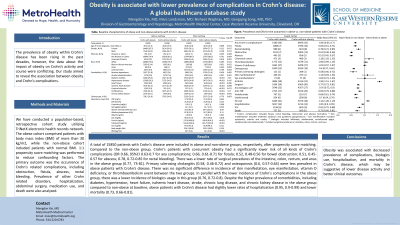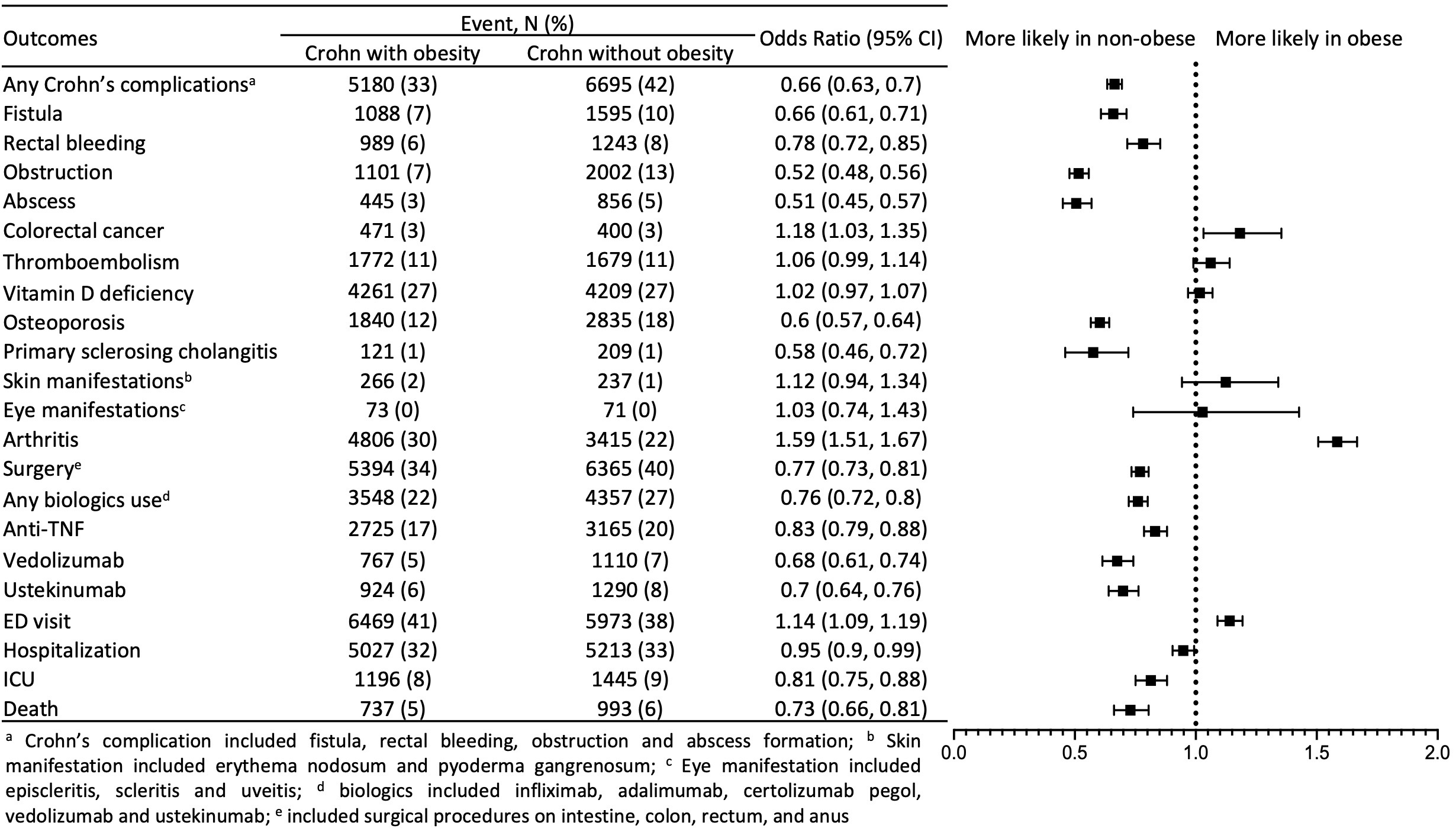Monday Poster Session
Category: IBD
P2149 - Obesity Is Associated With Lower Prevalence of Complications in Crohn’s Disease: A Global Healthcare Database Study
Monday, October 23, 2023
10:30 AM - 4:15 PM PT
Location: Exhibit Hall

Has Audio

Mengdan Xie, MD
MetroHealth Medical Center
Cleveland, Ohio
Presenting Author(s)
Mengdan Xie, MD1, Marc Landsman, MD2, Nisheet Waghray, MD3, Gengqing Song, MD2
1MetroHealth Medical Center, Cleveland, OH; 2MetroHealth Medical Center, Case Western Reserve University, Cleveland, OH; 3Case Western Reserve University/Metro Health, Cleveland, OH
Introduction: The prevalence of obesity within Crohn’s disease has been rising in the past decades, however, the data about the impact of obesity on Crohn’s activity and course were conflicting. Our study aimed to reveal the association between obesity and Crohn’s complications.
Methods: We conducted a population-based, retrospective cohort study utilizing TriNetX electronic health records network. The obese cohort comprised patients with body mass index (BMI) of more than 30 kg/m2, while the non-obese cohort included patients with normal BMI. 1:1 propensity score matching was performed to reduce confounding factors. The primary outcome was the occurrence of Crohn’s related complications, including obstruction, fistula, abscess, rectal bleeding. Prevalence of other Crohn related disorders, hospitalization, abdominal surgery, medication use, and death were also analyzed.
Results: A total of 15850 patients with Crohn’s disease were included in obese and non-obese groups, respectively, after propensity score matching. Compared to the non-obese group, Crohn’s patients with concurrent obesity had a significantly lower risk of all kinds of Crohn’s complications (OR 0.66, 95%CI 0.63-0.7 for any complications; 0.66, 0.61-0.71 for fistula; 0.52, 0.48-0.56 for bowel obstruction; 0.51, 0.45-0.57 for abscess; 0.78, 0.72-0.85 for rectal bleeding). There was a lower rate of surgical procedures of the intestine, colon, rectum, and anus in the obese group (0.77, 73-81). Primary sclerosing cholangitis (0.58, 0.46-0.72) and osteoporosis (0.6, 0.57-0.64) were less prevalent in obese patients with Crohn’s disease. There was no significant difference in incidence of skin manifestation, eye manifestation, vitamin D deficiency, or thromboembolism event between the two groups. In parallel with the lower incidence of Crohn's complications in the obese group, there was a lower incidence of biologics usage in this group (0.76, 0.72-0.8). Despite the higher prevalence of comorbidities, including diabetes, hypertension, heart failure, ischemic heart disease, stroke, chronic lung disease, and chronic kidney disease in the obese group compared to non-obese at baseline, obese patients with Crohn’s disease had slightly lower rates of hospitalization (0.95, 0.9-0.99) and lower mortality (0.73, 0.66-0.81).
Discussion: Obesity was associated with decreased prevalence of complications, biologics use, hospitalization, and mortality in Crohn’s disease, which may be suggestive of lower disease activity and better clinical outcomes.

Disclosures:
Mengdan Xie, MD1, Marc Landsman, MD2, Nisheet Waghray, MD3, Gengqing Song, MD2. P2149 - Obesity Is Associated With Lower Prevalence of Complications in Crohn’s Disease: A Global Healthcare Database Study, ACG 2023 Annual Scientific Meeting Abstracts. Vancouver, BC, Canada: American College of Gastroenterology.
1MetroHealth Medical Center, Cleveland, OH; 2MetroHealth Medical Center, Case Western Reserve University, Cleveland, OH; 3Case Western Reserve University/Metro Health, Cleveland, OH
Introduction: The prevalence of obesity within Crohn’s disease has been rising in the past decades, however, the data about the impact of obesity on Crohn’s activity and course were conflicting. Our study aimed to reveal the association between obesity and Crohn’s complications.
Methods: We conducted a population-based, retrospective cohort study utilizing TriNetX electronic health records network. The obese cohort comprised patients with body mass index (BMI) of more than 30 kg/m2, while the non-obese cohort included patients with normal BMI. 1:1 propensity score matching was performed to reduce confounding factors. The primary outcome was the occurrence of Crohn’s related complications, including obstruction, fistula, abscess, rectal bleeding. Prevalence of other Crohn related disorders, hospitalization, abdominal surgery, medication use, and death were also analyzed.
Results: A total of 15850 patients with Crohn’s disease were included in obese and non-obese groups, respectively, after propensity score matching. Compared to the non-obese group, Crohn’s patients with concurrent obesity had a significantly lower risk of all kinds of Crohn’s complications (OR 0.66, 95%CI 0.63-0.7 for any complications; 0.66, 0.61-0.71 for fistula; 0.52, 0.48-0.56 for bowel obstruction; 0.51, 0.45-0.57 for abscess; 0.78, 0.72-0.85 for rectal bleeding). There was a lower rate of surgical procedures of the intestine, colon, rectum, and anus in the obese group (0.77, 73-81). Primary sclerosing cholangitis (0.58, 0.46-0.72) and osteoporosis (0.6, 0.57-0.64) were less prevalent in obese patients with Crohn’s disease. There was no significant difference in incidence of skin manifestation, eye manifestation, vitamin D deficiency, or thromboembolism event between the two groups. In parallel with the lower incidence of Crohn's complications in the obese group, there was a lower incidence of biologics usage in this group (0.76, 0.72-0.8). Despite the higher prevalence of comorbidities, including diabetes, hypertension, heart failure, ischemic heart disease, stroke, chronic lung disease, and chronic kidney disease in the obese group compared to non-obese at baseline, obese patients with Crohn’s disease had slightly lower rates of hospitalization (0.95, 0.9-0.99) and lower mortality (0.73, 0.66-0.81).
Discussion: Obesity was associated with decreased prevalence of complications, biologics use, hospitalization, and mortality in Crohn’s disease, which may be suggestive of lower disease activity and better clinical outcomes.

Figure: Figure. Prevalence and ORs for the outcomes in obese vs. non-obese patients with Crohn’s disease
Disclosures:
Mengdan Xie indicated no relevant financial relationships.
Marc Landsman indicated no relevant financial relationships.
Nisheet Waghray indicated no relevant financial relationships.
Gengqing Song indicated no relevant financial relationships.
Mengdan Xie, MD1, Marc Landsman, MD2, Nisheet Waghray, MD3, Gengqing Song, MD2. P2149 - Obesity Is Associated With Lower Prevalence of Complications in Crohn’s Disease: A Global Healthcare Database Study, ACG 2023 Annual Scientific Meeting Abstracts. Vancouver, BC, Canada: American College of Gastroenterology.
